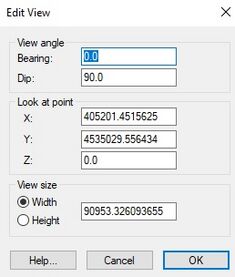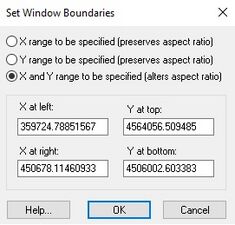GMS:Display Menu
The Display menu is one of the standard menus and is available in all of the modules. The commands in the Display menu are as follows:
Opens the Display Options dialog.
Opens the Contour Options dialog.
- Refresh Display
Clears and redraws the Graphics Window.
- Redraw Display
A more thorough version of Refresh Display, forces the regeneration of the display from the project data. Items are redrawn at the size specified in the Display Options.
- Frame Image
Adjusts the view so that all currently visible objects fit in the Graphics Window.
- Map Locator
Used to navigate to any place on Earth. The Graphics Window is positioned to the location shown in the Map Locator and the display projection is set to a global projection if not already in one.
Sets the projection used for the display.
- Visibility
A submenu for the Hide, Show and Isolate commands. These commands only act on the graphics objects associated with the current selection tool. If the current tool is not a selection tool, these commands are not available.
- File:Hide.PNG Hide – Causes the selected objects to become invisible.
- File:Show.PNG Show – Causes hidden objects to become visible.
- File:Isolate.PNG Isolate – Hides all but the selected objects.
- Views
A submenu with commands for altering the view in the Graphics Window.
- View Angle
The objects in the Graphics Window can be rotated and viewed in three dimensions. Two angles, bearing and dip, are used to rotate the view. The bearing and dip values correspond to a rotation about the z and x axes. The bearing affects the horizontal angle (rotating the object in the xy plane), and the dip changes the vertical angle (shifting the viewing angle on the object to a higher or lower perspective). The object cannot be tilted sideways. Using only two viewing angles rather than three limits the viewing angles, but it is simpler and more intuitive. The bearing and dip angles can be explicitly defined in the Edit Angle dialog accessed by selecting the View Angle command. The viewing angles can be manipulated interactively with the Rotate tool.
- Window Bounds
The region of the real world coordinate system that is mapped to the Graphics Window can be altered using the Pan and Zoom tools. It is also possible to precisely control the visible region by selecting the Set Window Bounds command from the View menu. This command brings up the Set Window Boundaries dialog. If the X range to be specified (preserves aspect ratio) option is selected, the x coordinate at the left and right and the y coordinate at the bottom of the Graphics Window are specified. The y coordinate at the top of the Graphics Window is not specified in order to maintain the aspect ratio. If the Y range to be specified (preserves aspect ratio) option is selected, the y coordinate at the top and bottom and the x coordinate at the left of the Graphics Window are specified. The x coordinate at the right of the Graphics Window is not specified in order to maintain the aspect ratio. If the X and Y range to be specified (alters aspect ratio) option is selected, the x coordinate at the right and left and y coordinate at the top and bottom of the Graphics Window are specified. Since all four coordinates are specified, the aspect ratio of the scene may be altered.
- File:PlanView.PNG Plan View – Changes the viewing angle so that the user is looking down the z-axis with the x-axis horizontal and the y-axis vertical.
- File:FrontView.PNG Front View – Changes the viewing angle so that the user is looking down the y-axis with the x-axis horizontal and the z-axis vertical.
- File:SideView.PNG Side View – Changes the viewing angle so that the user is looking down the x-axis with the y-axis horizontal and the z-axis vertical.
- File:OrthoView.PNG Oblique View – Changes the viewing angle so that the user is looking at the model at an angle of 45o to each axis.
- Previous – Restores the Graphics Window viewing parameters as they were before the last viewing command was issued (rotate, zoom, pan, etc.). Views are automatically saved in a list so continued use of this command will continue to restore previous views.
- General/Ortho Mode
A command is provided in the Display menu for switching between the orthogonal and general viewing modes. The orthogonal mode is only available with 3D grids.
Exports any visible geometric data to a CAD file. This command can also be found by right-clicking in the empty space in the Project Explorer.
- Toolbars
The Toolbars submenu allows the user to hide and show the listed toolbars.
Brings up the Plot Wizard dialog.
- Animate
The Animate command launches the Animation Wizard.
- Play Animation
The Play Animation command launches an *.avi player that allows the user to browse for an *.avi file and play the animation.
GMS – Groundwater Modeling System | ||
|---|---|---|
| Modules: | 2D Grid • 2D Mesh • 2D Scatter Point • 3D Grid • 3D Mesh • 3D Scatter Point • Boreholes • GIS • Map • Solid • TINs • UGrids | |
| Models: | FEFLOW • FEMWATER • HydroGeoSphere • MODAEM • MODFLOW • MODPATH • mod-PATH3DU • MT3DMS • MT3D-USGS • PEST • PHT3D • RT3D • SEAM3D • SEAWAT • SEEP2D • T-PROGS • ZONEBUDGET | |
| Aquaveo | ||

